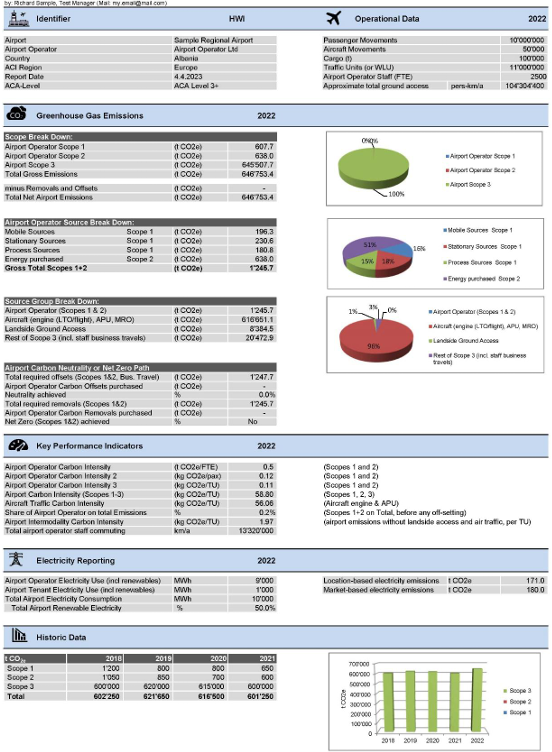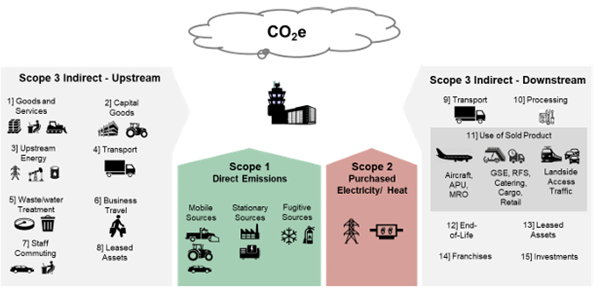The First Step: Facing the Numbers
When people talk about getting fit, the story almost always starts with a scale.
It’s that quiet, private moment when we confront reality — the moment of truth before all the plans, promises, and programs. We step on the scale not to punish ourselves, but to know where we stand.
Airports, surprisingly, are no different.
For all their technology and sophistication, most airports cannot manage what they have never truly measured: their own greenhouse gas emissions. Without knowing the numbers, sustainability remains an abstract slogan.
This is why the Airports Council International (ACI) created a tool called the Airport Carbon and Emission Reporting Tool (ACERT). It is essentially a scale for airports — a simple, spreadsheet-based calculator that lets operators “weigh” their emissions.
And just as the scale doesn’t require a nutritionist to operate, ACERT doesn’t require an environmental scientist. It uses information airports already have — fuel use, electricity bills, vehicle mileage, passenger numbers — and translates them into a comprehensive carbon inventory.
The result is a clear picture of where an airport’s emissions come from and how large they are. It’s the first, unavoidable step toward meaningful change.
The Power of Measurement
In management, there’s a saying: “What gets measured, gets managed.”
It’s a simple idea, but one that carries immense power.
You can’t manage what you don’t understand. And you can’t understand what you don’t measure.
For airports, measuring carbon emissions is not only about numbers; it’s about responsibility. It tells a story — about energy, efficiency, and choices.
ACI’s philosophy is straightforward: before reducing emissions, airports must first map them. This is the foundation of the Airport Carbon Accreditation (ACA) program — a global initiative that certifies airports based on how far they have gone in measuring, managing, and ultimately reducing their emissions.
In other words, ACERT provides the data, while ACA provides the recognition.
Together, they turn a moral aspiration into an operational discipline.
Scopes 1, 2, and 3 — Finding the Hidden Calories
Anyone who has ever tried to lose weight knows the biggest surprises are often in the “hidden calories.” The cream in your coffee. The dressing on your salad.
Airports have hidden calories, too.
In carbon accounting, these are called Scope 3 emissions — the indirect emissions that happen because of airport activity but are not fully under the airport’s control. They include the fuel burned by aircraft, the energy used by tenants, the buses and taxis that bring passengers, and even the production of goods that the airport buys.
ACERT classifies emissions in three layers:
Scope 1: Direct emissions from sources owned or controlled by the airport — vehicles, generators, boilers.
Scope 2: Indirect emissions from electricity or heat purchased from outside suppliers.
Scope 3: Indirect emissions from the wider airport ecosystem — aircraft operations, ground access vehicles, and supply chains.
Most of an airport’s total footprint lies in Scope 3 — the “hidden calories.”
And that’s precisely why ACERT’s latest version (v7.0, 2025) is so powerful: it captures the full range of emissions, upstream and downstream, so airports finally see their whole picture.
Because in any system, what you don’t see is often what matters most.
Transparency Builds Trust
Honest measurement requires courage.
In both personal fitness and institutional governance, facing uncomfortable data can be painful — but it’s the only way to improve.
ACI encourages airports to update their carbon inventories every year. That consistency matters more than perfection. In fact, the ACERT manual emphasizes: “Completeness is more important than accuracy.” Even rough estimates are better than silence.
This philosophy changes everything. It tells airports: don’t wait until your data is perfect. Start now, measure what you can, and refine it later.
By doing so, airports not only build better data — they build trust. Transparency becomes a signal of credibility. In a world increasingly sceptical of greenwashing, trust is priceless.
The public will forgive imperfect numbers. They will not forgive empty words.
From Scale to Certification: The ACA Ladder
If ACERT is the scale, then the Airport Carbon Accreditation (ACA) is the structured fitness program.
It recognizes airports’ progress through six levels — from simply knowing their carbon “weight” to achieving net-zero emissions.
- Level 1 – Mapping: Measuring and reporting emissions.
- Level 2 – Reduction: Demonstrating real cuts through efficiency.
- Level 3 – Optimization: Engaging airlines, tenants, and service partners.
- Level 3+ – Neutrality: Offsetting remaining emissions.
- Level 4 and 4+: Integrating climate goals into long-term business strategy.
- Level 5: Achieving full net-zero carbon
Each level demands verification, data, and continuous effort.
Just like personal fitness, there are no shortcuts — only progress.
What makes ACA special is that it recognizes every step. A small regional airport that completes its first carbon map is celebrated as much as a major international hub that reaches neutrality. Because the real milestone is not the level itself — it’s the decision to begin.
Indonesia’s Opportunity
Indonesia operates more than 300 airports — from the mega-hubs of Jakarta and Bali to the small pioneer strips connecting remote islands. Yet only a handful have joined the ACA program.
That can change. And it should.
Indonesia’s aviation sector is growing fast, but growth without sustainability risks a heavy future burden. If airports nationwide start using ACERT, they can build a consistent national database of emissions — a kind of BMI chart for the country’s entire airport system.
This data could feed into Indonesia’s Nationally Determined Contribution (NDC) under the Paris Agreement and its Net Zero 2060 roadmap. It would also enhance Indonesia’s standing in global aviation diplomacy, showing that a developing nation can lead not through declarations, but through data.
ACERT’s greatest advantage is accessibility: it’s free, Excel-based, and easy to use. Even a modest airport with no dedicated environmental unit can participate.
The act of measuring itself becomes a democratic tool — proof that climate action is not limited to the wealthy or the powerful.
Learning from the World
The global experience with ACERT is encouraging.
Zurich Airport used the tool to benchmark emissions and achieved a 10 percent cut in energy use within two years.
Toronto Pearson integrated ACERT results into its annual sustainability reports, linking carbon performance with financial outcomes.
Seattle–Tacoma Airport applied ACERT to design a renewable energy program that significantly lowered carbon intensity per passenger.
Even Quito Airport in Ecuador reported that ACERT was “a wonderful solution to calculate the airport’s carbon footprint — very easy to use, and it does everything for you.”
Tests show that ACERT’s estimates for direct emissions (Scopes 1 and 2) are within 5–10 percent of detailed professional audits. That’s a remarkable level of accuracy for a no-cost tool.
These examples prove a crucial point: meaningful climate action doesn’t always require expensive consultants. It requires willingness — the courage to measure, to learn, and to improve.
From Compliance to Culture
Carbon accounting may start as compliance, but its real value lies in culture.
When airport staff in operations, maintenance, or even finance begin to understand how their daily work affects emissions, sustainability becomes a shared mindset rather than a separate department.
Every action — switching to LED lighting, optimizing taxiway movement, managing waste — becomes part of a larger narrative of responsibility.
ACERT helps create that awareness. It translates abstract climate science into numbers people can touch and understand. Over time, these numbers of shape habits, and habits build culture.
It’s the same transformation that happens when individuals start tracking their steps or calories. Data makes behaviour visible, and visibility inspires change.
Challenges on the Road to Carbon Fitness
Every journey of change meets resistance. For airports, there are real challenges ahead:
- Data Gaps: Many smaller airports still lack reliable records of fuel or energy use.
- Shared Responsibility: Large portions of emissions come from airlines and tenants beyond the airport’s direct control.
- Funding: Measuring is cheap; mitigating requires capital — for renewable energy, electric ground vehicles, or waste systems.
- Consistency: Annual measurement demands continuity, even as managers change.
But these are not reasons to wait.
The act of measuring is itself a catalyst. Once an airport knows its numbers, it becomes impossible to unsee them. Data creates moral gravity — the pull toward doing better.
The Psychology of Measurement
There is a deeper psychology behind all this.
Measurement changes behaviour because it turns the invisible into the visible.
When you see the number on the scale, it becomes real.
When an airport sees its carbon footprint on a chart, decisions suddenly have weight. Fuel isn’t just fuel; it’s carbon. Electricity isn’t just a cost; it’s climate.
This visibility sparks awareness — and awareness is the seed of responsibility.
In that sense, ACERT is more than a technical tool. It’s a mirror. And sometimes, that’s what institutions need most — a mirror that reflects not guilt, but truth.
From Data to Diplomacy
Climate action is not only about internal efficiency; it’s also about external credibility.
In international aviation, reputation matters. Recognition, such as the ICAO Council President Certificate, rewards verifiable achievement, not promises.
For Indonesia, a network of ACA-certified airports could strengthen its diplomatic profile — positioning the country as a bridge between developed and developing aviation economies.
It would show that transparency, not wealth, is the real currency of global environmental leadership.
A Path Forward
So what can Indonesia — and the region — do next?
- Make ACERT Standard Practice: Require all airports to maintain annual carbon inventories.
- Train the People: Build capacity for staff to collect and analyze data.
- Climb the Ladder: Start with ACA Level 1 (Mapping) and move upward progressively.
- Be Transparent: Publish results to build trust with the public.
- Link Policy to Data: Use airport carbon KPIs to inform national climate reporting and investment decisions.
These are practical, achievable steps.
They don’t demand massive budgets — only steady commitment and honest measurement.

Sample of report
The Moral of the Scale
In the end, stepping on the scale is not about shame. It’s about self-awareness.
The same goes for airports. Measuring carbon emissions is not about guilt — it’s about growth.
Airports are gateways to the world. They can also be gateways to a sustainable future. By embracing ACERT and ACA, airports turn good intentions into measurable progress.
Each tonne of CO₂ reduced is a small act of stewardship — proof that technology and responsibility can coexist.
And perhaps that’s the larger message: before we can fly higher, we must first learn to weigh ourselves honestly.
Conclusion: From Numbers to Leadership
The success of Airport Carbon Accreditation will ultimately be judged not by how many plaques hang on terminal walls, but by how much cleaner the skies become.
Sustainability is not a destination; it’s a habit.
Like health, it requires discipline, reflection, and renewal.
Indonesia now stands at a promising crossroads — an aviation nation ready to lead not only in connectivity but in conscience.
By making measurement a way of life, Indonesia can show that the journey to a greener world does not begin with slogans or technologies, but with humility — the courage to step on the scale.
Before we can become lighter as a planet, we must first dare to know our weight.
References
Airports Council International (2025). ACERT User Manual Version 7.25xx (English). Montréal: ACI World.
Airports Council International (2025). ACERT v7.0 Brochure – Do-It-Yourself Airport Greenhouse Gas Inventory Tool.
International Civil Aviation Organization (ICAO). Long-Term Aspirational Goal (LTAG) for Net-Zero 2050.
ACI Airport Carbon Accreditation. Global Airport Carbon Management Standard.
Pérez-Basantes, J. (2024). Testimony on ACERT Implementation at Quito Airport, ACI LAC Environment Committee.

